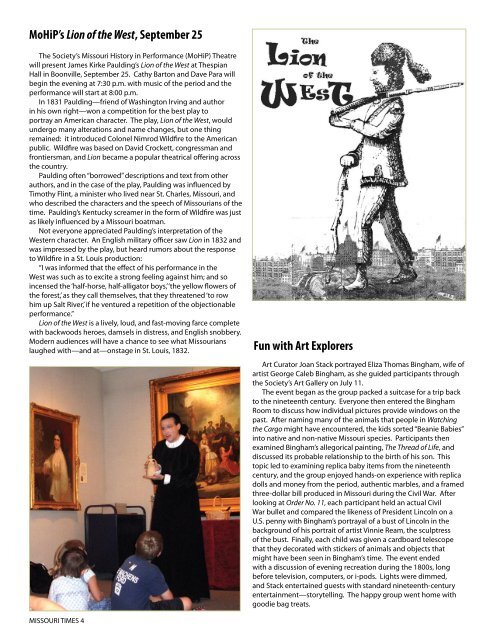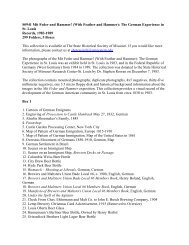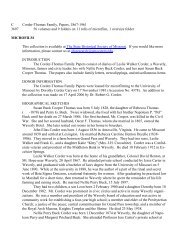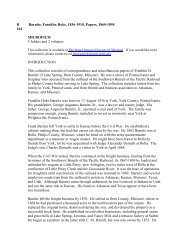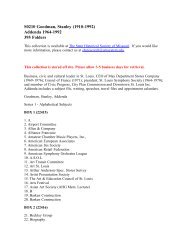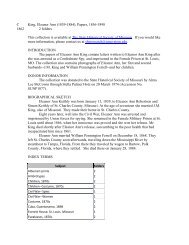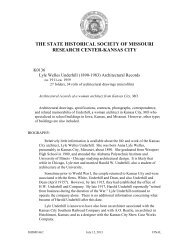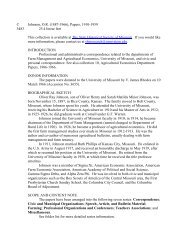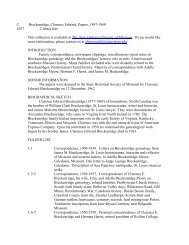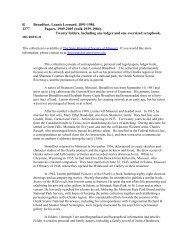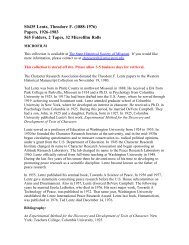MISSOURI TIMES - The State Historical Society of Missouri
MISSOURI TIMES - The State Historical Society of Missouri
MISSOURI TIMES - The State Historical Society of Missouri
Create successful ePaper yourself
Turn your PDF publications into a flip-book with our unique Google optimized e-Paper software.
MoHiP’s Lion <strong>of</strong> the West, September 25<br />
<strong>The</strong> <strong>Society</strong>’s <strong>Missouri</strong> History in Performance (MoHiP) <strong>The</strong>atre<br />
will present James Kirke Paulding’s Lion <strong>of</strong> the West at <strong>The</strong>spian<br />
Hall in Boonville, September 25. Cathy Barton and Dave Para will<br />
begin the evening at 7:30 p.m. with music <strong>of</strong> the period and the<br />
performance will start at 8:00 p.m.<br />
In 1831 Paulding—friend <strong>of</strong> Washington Irving and author<br />
in his own right—won a competition for the best play to<br />
portray an American character. <strong>The</strong> play, Lion <strong>of</strong> the West, would<br />
undergo many alterations and name changes, but one thing<br />
remained: it introduced Colonel Nimrod Wildfire to the American<br />
public. Wildfire was based on David Crockett, congressman and<br />
frontiersman, and Lion became a popular theatrical <strong>of</strong>fering across<br />
the country.<br />
Paulding <strong>of</strong>ten “borrowed” descriptions and text from other<br />
authors, and in the case <strong>of</strong> the play, Paulding was influenced by<br />
Timothy Flint, a minister who lived near St. Charles, <strong>Missouri</strong>, and<br />
who described the characters and the speech <strong>of</strong> <strong>Missouri</strong>ans <strong>of</strong> the<br />
time. Paulding’s Kentucky screamer in the form <strong>of</strong> Wildfire was just<br />
as likely influenced by a <strong>Missouri</strong> boatman.<br />
Not everyone appreciated Paulding’s interpretation <strong>of</strong> the<br />
Western character. An English military <strong>of</strong>ficer saw Lion in 1832 and<br />
was impressed by the play, but heard rumors about the response<br />
to Wildfire in a St. Louis production:<br />
“I was informed that the effect <strong>of</strong> his performance in the<br />
West was such as to excite a strong feeling against him; and so<br />
incensed the ‘half-horse, half-alligator boys,’ ‘the yellow flowers <strong>of</strong><br />
the forest,’ as they call themselves, that they threatened ‘to row<br />
him up Salt River,’ if he ventured a repetition <strong>of</strong> the objectionable<br />
performance.”<br />
Lion <strong>of</strong> the West is a lively, loud, and fast-moving farce complete<br />
with backwoods heroes, damsels in distress, and English snobbery.<br />
Modern audiences will have a chance to see what <strong>Missouri</strong>ans<br />
laughed with—and at—onstage in St. Louis, 1832.<br />
<strong>MISSOURI</strong> <strong>TIMES</strong> 4<br />
Fun with Art Explorers<br />
Art Curator Joan Stack portrayed Eliza Thomas Bingham, wife <strong>of</strong><br />
artist George Caleb Bingham, as she guided participants through<br />
the <strong>Society</strong>’s Art Gallery on July 11.<br />
<strong>The</strong> event began as the group packed a suitcase for a trip back<br />
to the nineteenth century. Everyone then entered the Bingham<br />
Room to discuss how individual pictures provide windows on the<br />
past. After naming many <strong>of</strong> the animals that people in Watching<br />
the Cargo might have encountered, the kids sorted “Beanie Babies”<br />
into native and non-native <strong>Missouri</strong> species. Participants then<br />
examined Bingham’s allegorical painting, <strong>The</strong> Thread <strong>of</strong> Life, and<br />
discussed its probable relationship to the birth <strong>of</strong> his son. This<br />
topic led to examining replica baby items from the nineteenth<br />
century, and the group enjoyed hands-on experience with replica<br />
dolls and money from the period, authentic marbles, and a framed<br />
three-dollar bill produced in <strong>Missouri</strong> during the Civil War. After<br />
looking at Order No. 11, each participant held an actual Civil<br />
War bullet and compared the likeness <strong>of</strong> President Lincoln on a<br />
U.S. penny with Bingham’s portrayal <strong>of</strong> a bust <strong>of</strong> Lincoln in the<br />
background <strong>of</strong> his portrait <strong>of</strong> artist Vinnie Ream, the sculptress<br />
<strong>of</strong> the bust. Finally, each child was given a cardboard telescope<br />
that they decorated with stickers <strong>of</strong> animals and objects that<br />
might have been seen in Bingham’s time. <strong>The</strong> event ended<br />
with a discussion <strong>of</strong> evening recreation during the 1800s, long<br />
before television, computers, or i-pods. Lights were dimmed,<br />
and Stack entertained guests with standard nineteenth-century<br />
entertainment—storytelling. <strong>The</strong> happy group went home with<br />
goodie bag treats.


